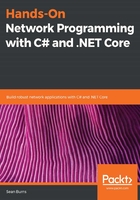
Summary
Looking back, this chapter covered the lowest-level details of network communication. First, we learned about the three most common constraints of a physical network infrastructure that demand the decomposition of a network request into packets. We looked at how different aspects of the hosting context of our application can contribute some measure of latency to our requests, how bandwidth can change the way requests move from one node to another, and how signal strength can compromise the integrity of a packet.
Next, we explored how those factors necessitate small, contextually-complete, atomic packets as our transport format for network requests. We unpacked how some common protocols provide that complete context with each packet through standardized formats. This gave us a clearer idea of how a larger network request is decomposed and sent over our network pipes.
Finally, we looked at how a set of packets, delivered at inconsistent intervals, can be consumed as a sequential stream. With all of this, the lowest level of our foundation is set, and we have the complete context of network infrastructure and communication standards necessary to fully explore how C# provides that functionality in our .NET Core applications. And that's exactly what we'll be looking at in the next chapter, as we finally generate a network request in a user-facing application, and fully unpack every step of that process as implemented by the .NET Core hosting platform.